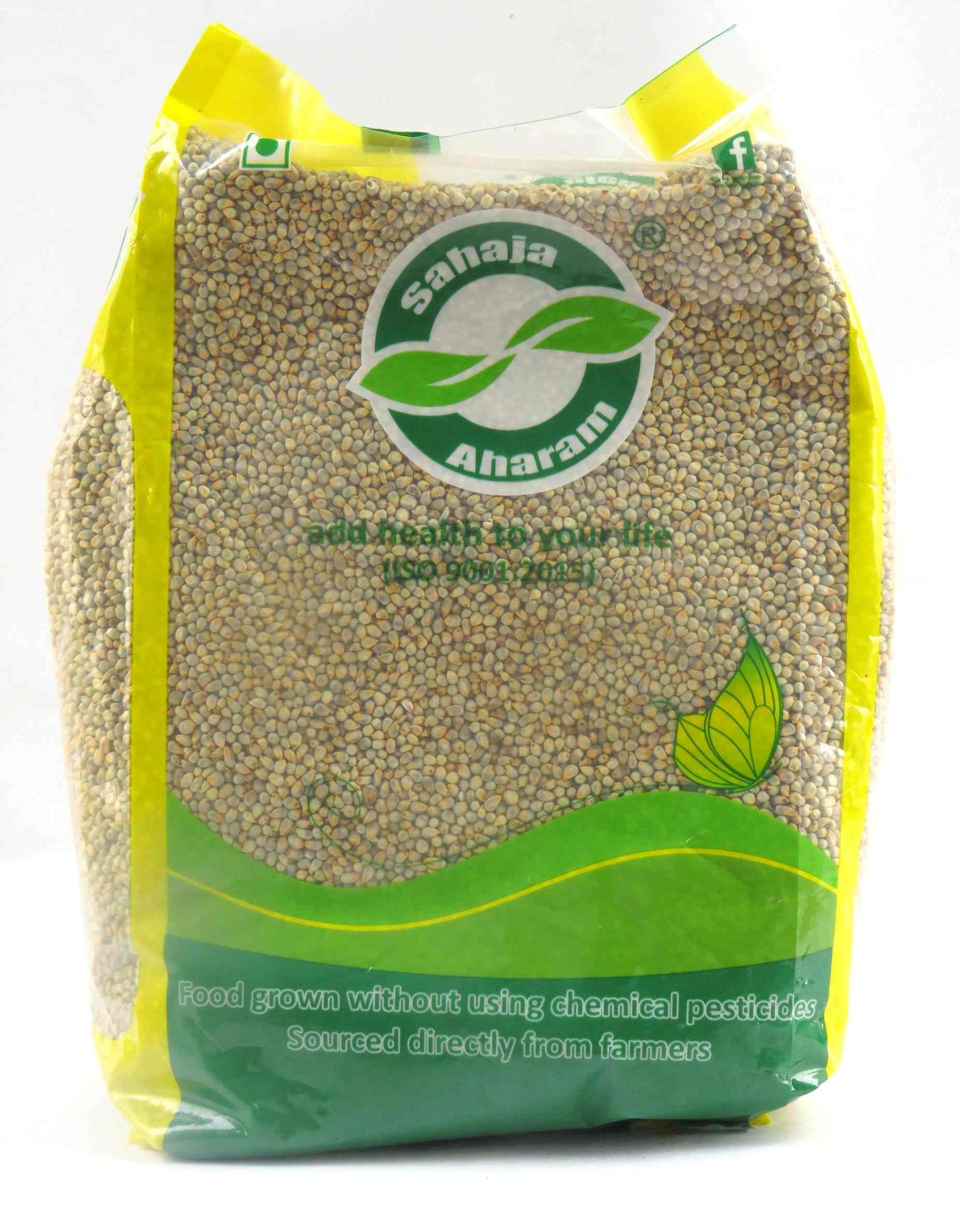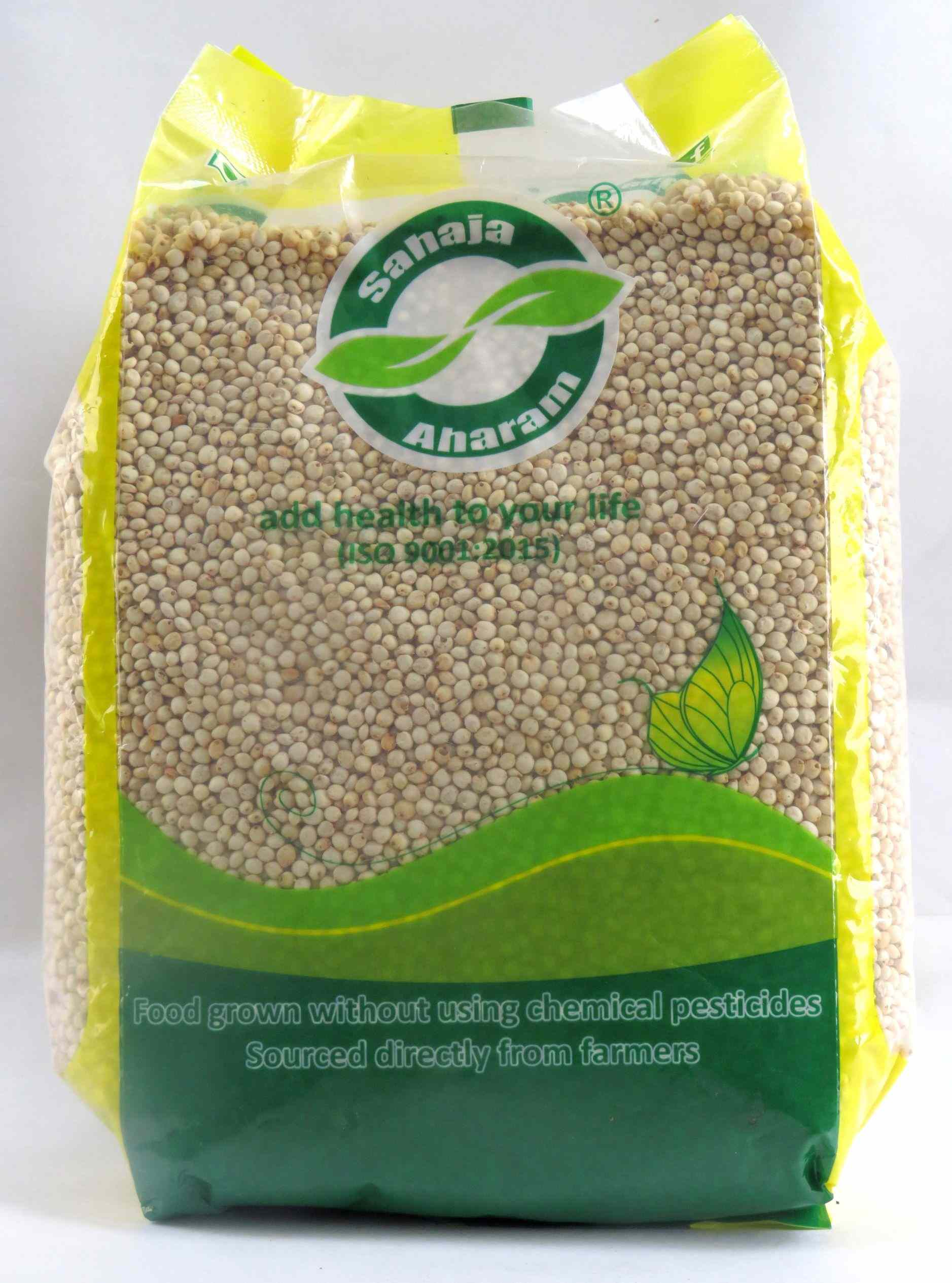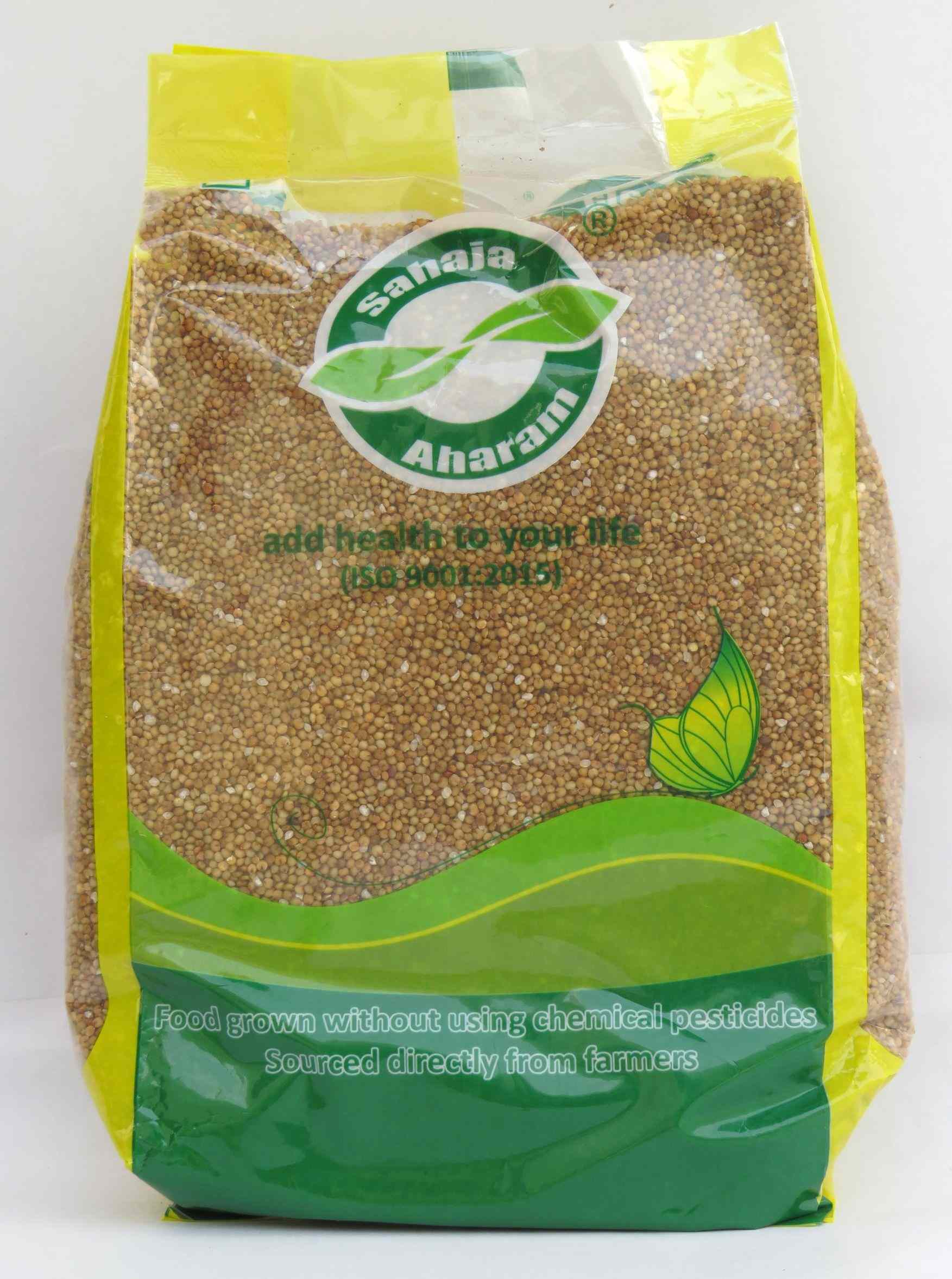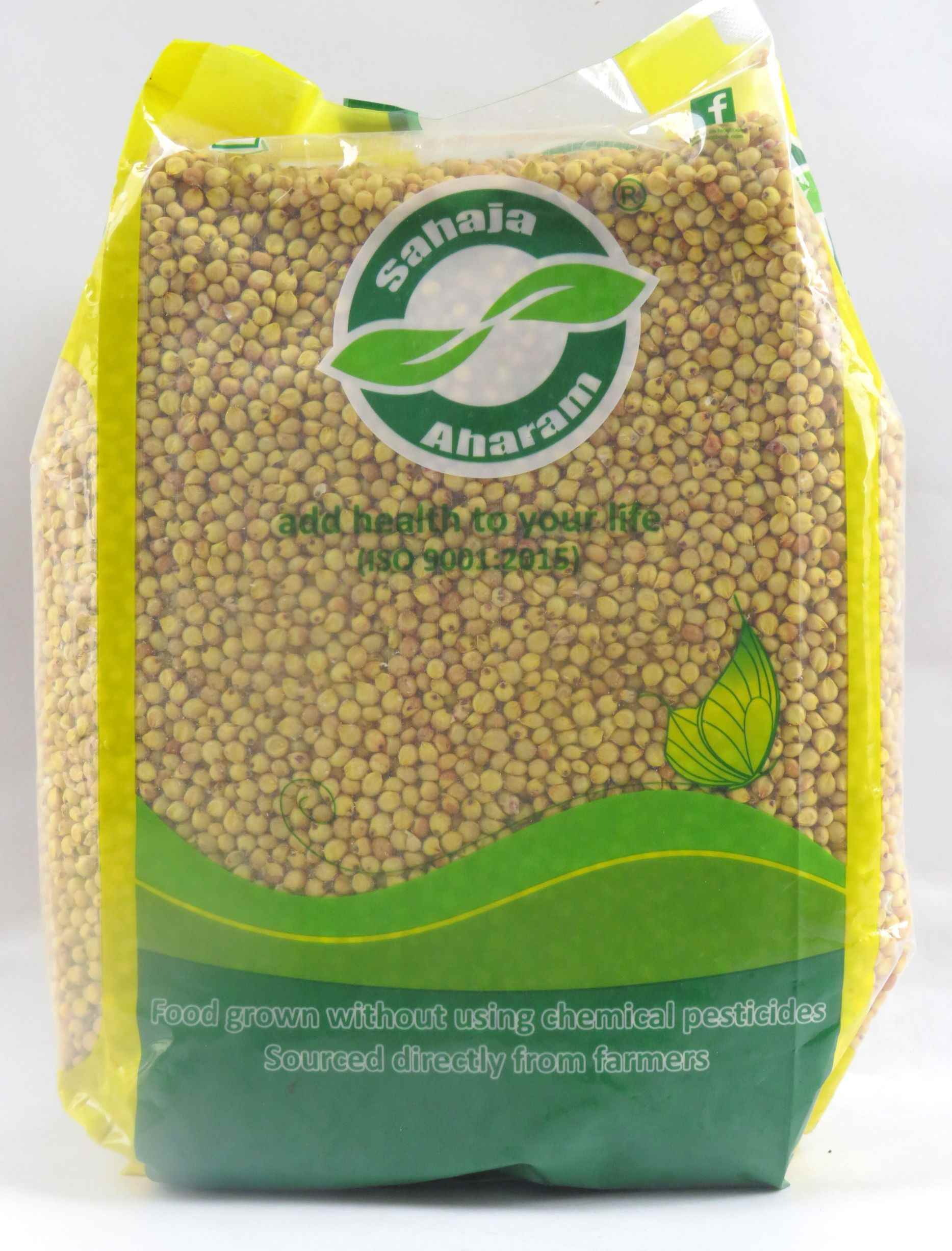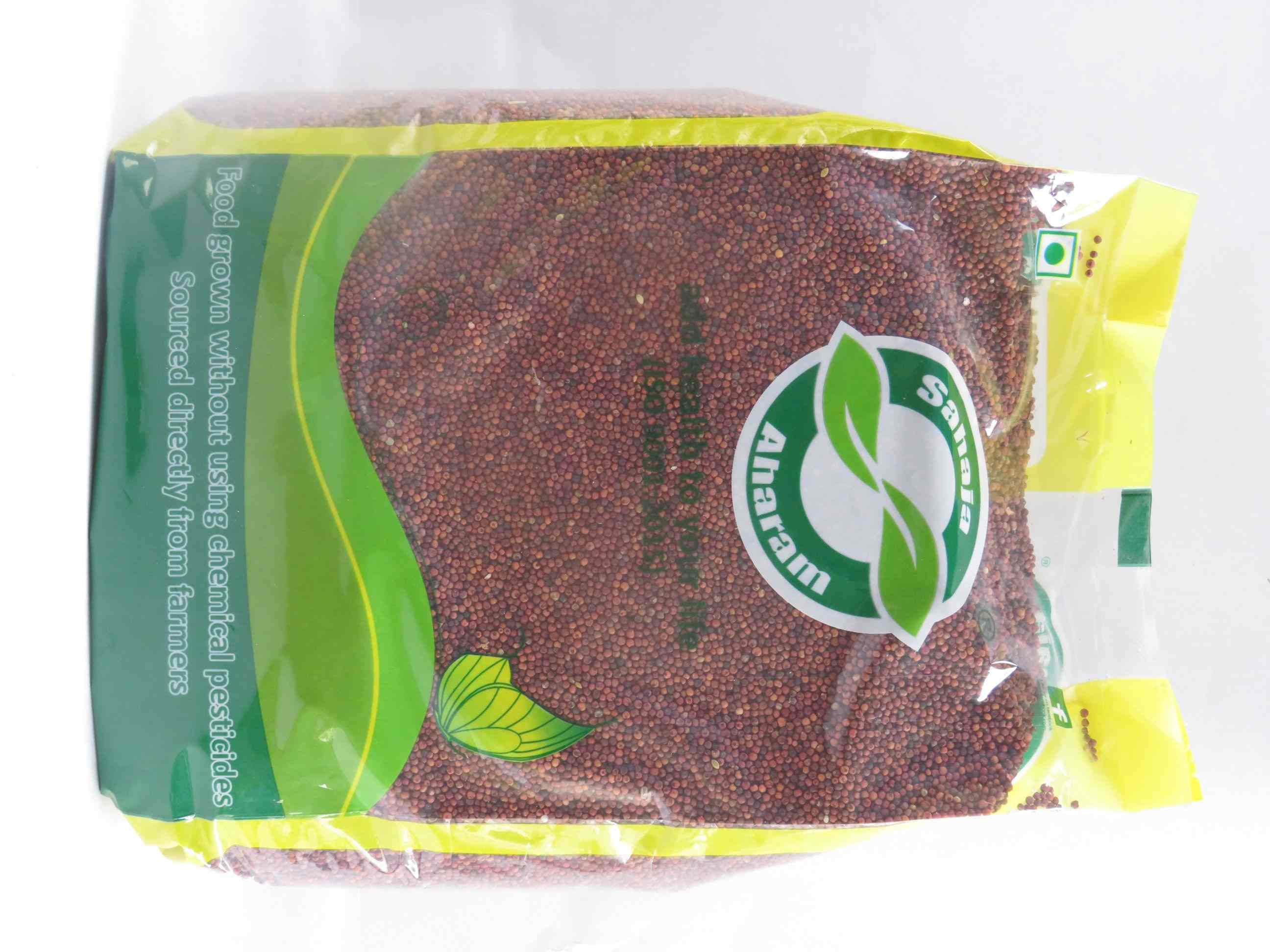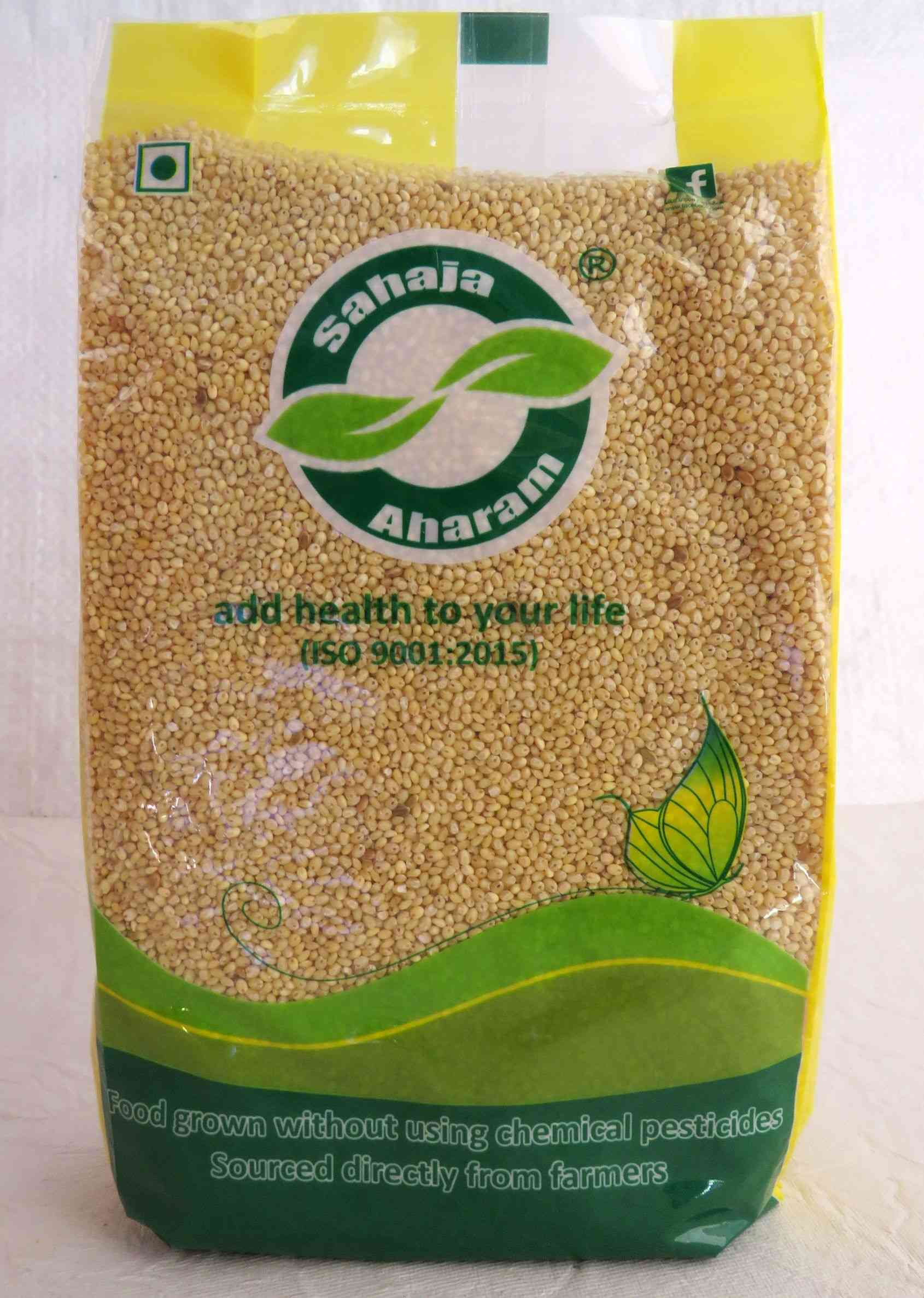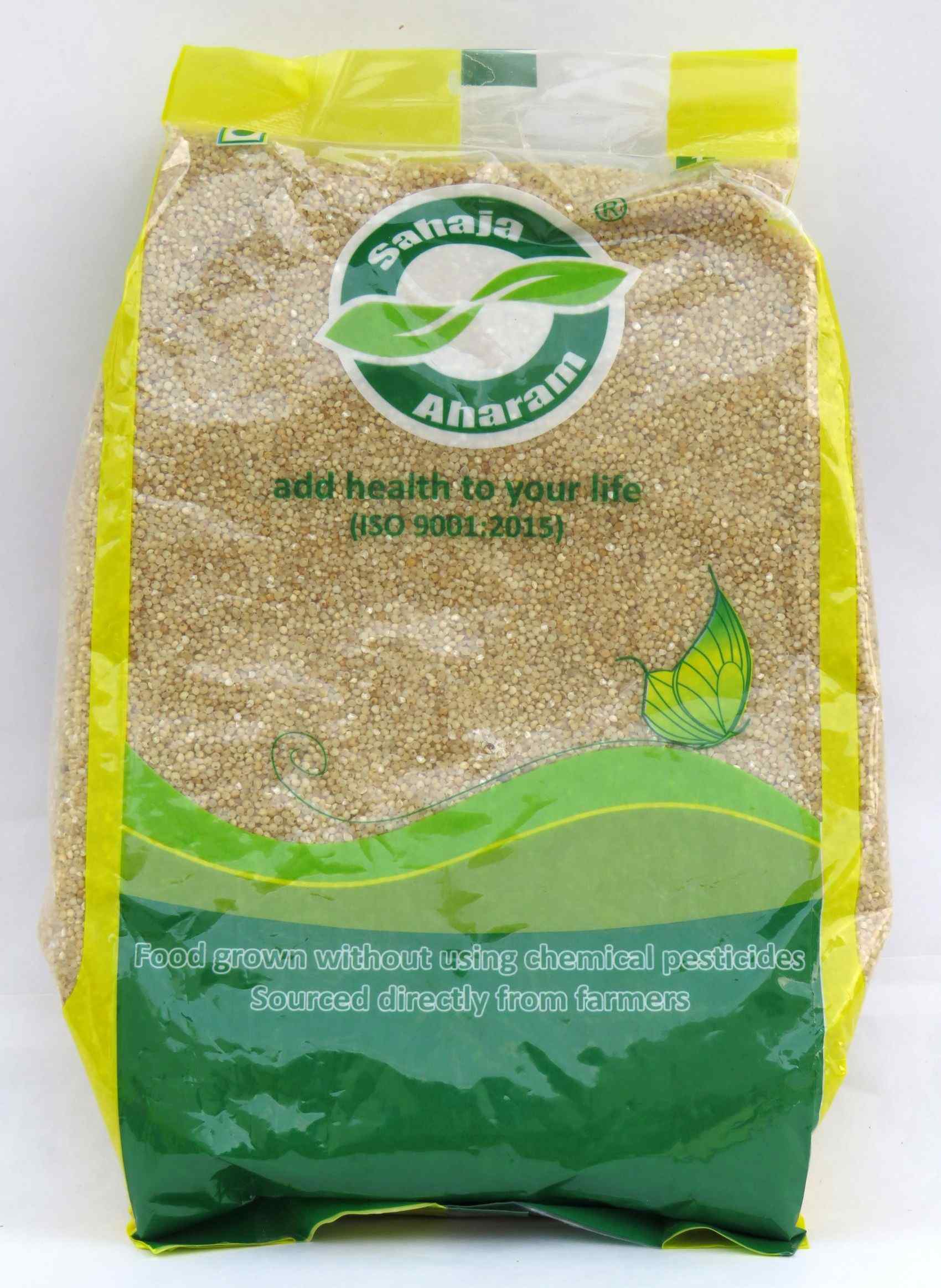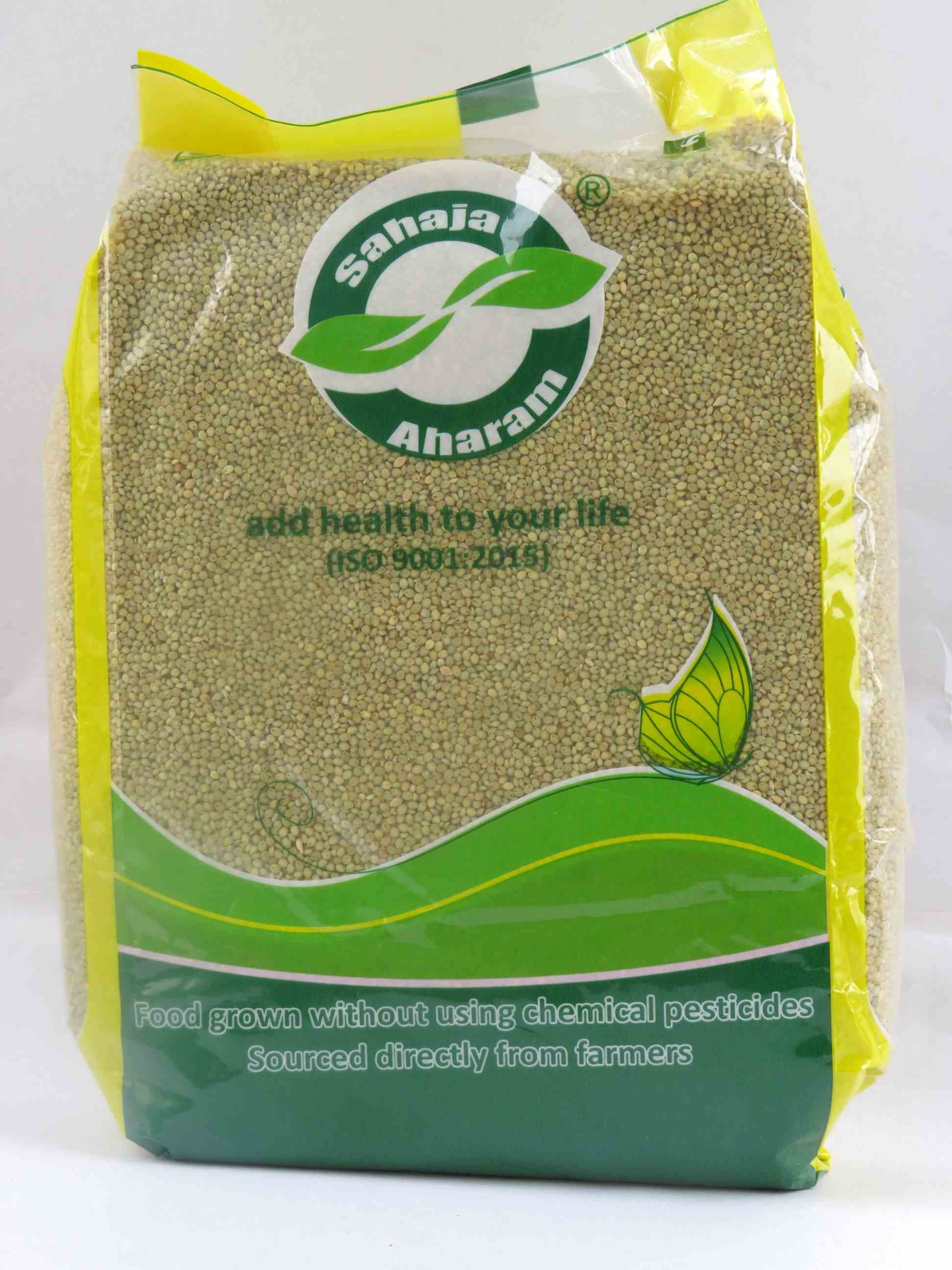Millets
Sahaja Bajra- Pearl Millet
A gluten-free and organically grown cereal also known as Sajjalu is used a lot in the rural India. It has a nutty and bittersweet after taste. Sahaja Bajra Millets are grown without chemical pesticides and is a good healthy food.
Nutritional values - High in proteins, iron, calcium, magnesium, folic acid and dietary fibre content. Has zinc, copper and over 20 micronutrients and high levels of antioxidants. Higher in calorie count than wheat.
Health Benefits - Promotes a healthy nervous system, lowers risk of obesity, Diabetes & cardiovascular diseases, burns fat, controls blood sugar level, healthy bones, boosts blood circulation, prevent anemia and overcomes acidity.
Cooking tips - This can be used in baking products like bread, cookies, muffins, chapatis, biscuits, dhoklas and chaklis. Usually used in Winters as it keeps the body warm. To be consumed fresh and thus best to purchase in small quantities. Can be used in baking products like bread, cupcakes, cookies, muffins, chapatis, biscuits, dhoklas and chaklis. A Maharashtrian multi-grain savoury dish Thalipeeth, made with Bajra flour, along with rice and Chickpea flour. 'Bajra ki roti' with 'Sarso ka saag' is very popular in Rajasthan.
More details
Sahaja White Jowar
White Jowar/Sorghum Millet (Jonna), a popular Indian crop belonging to the grass family,Gramineae, is gluten-free, rich, bitter and fiborous in nature. Sahaja White Jowar Millets are organically grown, pesticide free and are procured directly from our farmer. It is a good, healthy and a nutritious food item!
Nutritional values - Rich in proteins like iron, copper, zinc, potassium, phosphorous but low in calcium and sodium. Has high dietary fibre, and a complex carbohydrate source. Has slow digestible starch (SDS). It is an excellent source of antioxidant phytochemicals such as polyphenols, flavonoids and condensed tannins.
Health benefits - Manages obesity, facilitates digestion, regulates blood sugar levels, curbs the risk of high blood pressure and strokes. Good for weight watchers as the fibre takes longest time to digest. Builds muscles, good for Diabetic & gluten intolerant people.
Cooking tips - Can be washed, dried, grinded to flour and can be used as a roti dough and make them using palm. Being gluten-free, it lacks the elasticity like in wheat flour or white flour. Can also be mixed with other flours to make other dishes. Jowar kernels can be steamed, boiled, added to soups or stews. Popped over fire or roasted jowar kernels are eaten as a snack with seasoning. The flour can be used in Indian breads like Bhakris (thick chapatis), Thalipeeth, Gujarati snacks like Khichu, Khakra Muthia (Gujarati Dumpling), Panki, etc. and even cakes, cookies, breads. Can be used in porridges, Tacos (wheat flour, jowar flour, butter and warm water).
More details
Sahaja Kodo Millet
Kodo Millet (Arikelu) is the annual grain, grown without pesticides and organically and it varies in colour from light red to dark grey and like most of the millets possess high content of dietary fibre. Sahaja Kodo Millets are organically grown, pesticide free and procured directly from our farmers. A healthy and nutritious food on your plate!
Nutritional values - Gluten-free. Rich in dietary fibre, proteins more than regular rice or wheat, carbohydrates, good fat, minimal amount of iron and calcium. It has high amounts of polyphenols, an antioxidant compound.
Health benefits - Controls Diabetes, risk of obesity, prevent rise in cholesterol and triglyceride levels, promotes anti-bacterial activity, beneficial for post-menopausal women suffering from signs of cardiovascular disease like high blood pressure, makes feel fuller with less consumption and strengthening nervous system.
Cooking tips - Ground it to flour to prepare roti/chapati or use it like regular white rice. and for it the millet-water ratio = 1:2 cups. A good substitute for rice and wheat and good choice of animal fodder.
What can be prepared? Same as other millets, like grinding the flour out of the grains and using it in Dosa/Idli batter or mixing it with Wheat flour for Roti, Chapati, Paratha, Naan, Bhakri, etc. Use in desserts or bakery items instead of refined flour. Cook it like regular rice and serve with curry/lentils or as pulav, khichdi with raita. Dry roast them before preparing upma or payasam.
More details
Sahaja Yellow Jowar
White Jowar/Sorghum Millet (Jonna), a popular Indian crop belonging to the grass family,Gramineae, is gluten-free, rich, bitter and fibrous in nature. It is made by grinding the organically grown small round yellow grains of jowar. Sahaja Yellow Jowar Millets are organically grown, pesticide free and are procured directly from our farmer. It is a good, healthy and a nutritious food item!
Nutritional values - This yellow variety is rich in carotenoids like beta carotene, lutein and zeaxanthin, proteins like iron, copper, zinc, potassium, phosphorus but low in calcium and sodium. High dietary fibre, and a complex carbohydrate source. Excellent source of antioxidant phytochemicals such as polyphenols, flavonoids and condensed tannins.
Health benefits - The extra plant pigments are good for age-related macular degeneration (AMD). Manages obesity, facilitate digestion, regulate blood sugar levels, curbs the risk of high blood pressure and strokes. Good for weight watchers as the fibre takes longest time to digest. Build muscles, good for Diabetic & gluten intolerant people.
Cooking tips - As it is gluten-free, it lacks the elasticity like in wheat flour or white flour, and one can shape rotis with their palm. Can also be mixed with other flours to make other dishes. Jowar kernels can be steamed, boiled, added to soups or stews. Popped over fire or roasted jowar kernels are eaten as a snack with seasoning. The flour can be used in Indian breads like Bhakris (thick chapatis), Thalipeeth, Gujarati snacks like Khichu, Khakra Muthia (Gujarati Dumpling), Panki, etc. and even cakes, cookies, breads. Can be used in porridges, Tacos (wheat flour, jowar flour, butter and warm water).
More details
Sahaja Ragi Whole
Finger Millet (Ragi in Telugu) is also called African Finger Millet. It is a seeded annual cereal which is grown for its seeds. The seeds, may be white, light brown or dark brown, are consumed in a variety of forms including as unleavened bread made from the flour.
Sahaja Ragi Millets are organically grown, pesticide free and procured directly from our farmers. A good, healthy and nutritious food item!
Nutritional values - It's grains are rich in protein, vitamins, minerals, fiber content and energy as compared to other cereals. It is also enriched with manganese, phosphorus, iron, copper, chromium, magnesium, zinc, molybdenum and selenium. It is superior to rice and wheat as it contains essential amino acids such as methionine and tryptophan.
Health benefits - Being gluten free,it is suitable for those who are gluten intolerant. Keeps our bones and teeth healthy, low glycemic index lessens food cravings and maintains the digestive pace and helps in controlling Diabetes. Reverts skin ageing with the amino acids like Methionine and Lysine, battles Anemia, helps in weight loss and relaxes the body. It is great for the people with low Hemoglobin levels and very helpful for girls/ladies during Menstruation or Menopause period.
Cooking tips - Grind the grains into flour (spouting, drying and then grinding the grains)and mix it with the wheat flour to make Chapatis, Parathas, baking products like cookies (available in our stores)or mix it in the idli/dosa batter (also available in our stores). Dilute the flour in curd or milk and make a Porridge. Baking - if the flour is too dense, mix it with wheat flour in the ratio of 7:3 and make breads or bake with it. A great ingredient for Indian traditional desserts like Bobbattulu (Sweet stuffed paratha), Sweet appalu, Kheer/Payasam, Gavvalu, etc.
The colour of the cooked Ragi is Dark Brown.
More details
Sahaja Proso Millet
Proso Millet (Varigalu) is a warm season grass, highly nutritious cereal grain used for human consumption, but more common for bird feeding. It's colour ranges from yellow, cream, orange to red or brown.
Sahaja Proso Millets are organically grown and pesticide free. It is procured directly from the farmers. Add health to your life!
Nutritional values - It's low glycemic index has made it a fad among weight watchers. Gluten-free, numerous amounts of fatty acids and carbohydrates. It also has minerals like magnesium, manganese, phosphorous, etc. Provides adequate zinc, vitamin B6, iron. Rich in dietary fibre.
Health benefits - helps in reducing the blood pressure, decreases the chances of strokes/heart attacks, dietary fibre eliminates bad cholesterol and maintains good cholesterol. Prevents diabetes, lowers gastrointestinal problems like colon cancer and gastric ulcers. It prevents the outbreak of breast cancer. Antioxidants clears the toxins from liver and kidney. Improves asthma. Slows down the ageing process and strengthens the bones.
Cooking tips - Seeds are cooked as a whole grain and also grounded into a powder which is used to make breads, roti/paratha, idli, dosa and pasta. Upma with vegetables. Sprouted seeds are added to soups, salads. Can be used for baking like cake, muffins, etc. Can be served in our regular meals along with curry or dal. It can also be added in casserole, pancakes, porridge and smoothies. Other names for this millet - Common Millet, Hog Millet, Broomtail Millet, Broomcorn Millet, Broom Millet, Red Millet, White Millet, and Black seeded Proso Millet.
More details
Sahaja Foxtail Millet Rice
Foxtail Millet (Korra) is a husked grain which has an indigestible seed coat which makes it more fibrous. It has blood sugar balancing carbohydrates, and it is popularly available in the form of semolina and rice flour.
Sahaja Foxtail Millets are grown organically, pesticide free and procured directly from our farmers. Add health to your life!
Nutritional values - Gluten-free cereal that improves digestion, increases energy level, helps in maintaining cholesterol and eliminating virus and germs from the body. Enriched with a rich source of fibre, minerals like magnesium, phosphorous, iron, calcium, zinc and potassium. Antioxidants (Tryptophan and amino acids) helps in curing disorders like insomnia and migraine.
Health benefits - Helps to regulate blood pressure, and reduce LDL levels, a good source of strengthening the immunity, cures insomnia and migraine, rich fibre content prevents breast cancer, maintains the bone health. These in the form of sprouts helps fight osteoporosis and could reduce the risk of fracture.
Cooking tips - Millet-water ratio = 1:2½ cups. Soak it for at least an hour.
What can be prepared? Breakfast and starters - Idli/Dosa, Upma, Porridge with dry-fruits and milk, pongal. For thickening soups or as a base for warm grain salads. Baking - can be added to breads, muffins for extra crunch. Main course - Eat it with curry/dal, stirred fried vegetables. Pulav, Biryani, Khichadi, Desserts - Kheer/Payasam, Bobbattulu (sweet paratha), Appalu (Wheat crackers), Sweet pongal and can try many more likewise.
More details
Sahaja Barnyard Millets
Barnyard Millet (Udalu) is a wild seed and not a grain. Also known as Sanwa(Hindi), Moraiyo (Gujarati) is a fastest growing crop. Small seeds of Barnyard millet are processes on groats which are then used in the preparation of different types of porridges. Sahaja Barnyard Millets are organically grown, without any chemical pesticides and we get directly from our farmers.
Nutritional values - Low in calories and carbohydrates, high levels of dietary fibre, calcium and phosphorous. Predominantly starchy. Gluten free grain.
Health benefits - Feels light and energetic, prevents constipation, excess gas, bloating, cramping, helpful for diabetes and cardiovascular diseases.
Cooking tips - Tastes similar to broken rice when cooked. Does not cook into separate grains like long grained rice. It is sticky once cooked and stays a bit soggy. The grains are smaller than Saboodana and bigger than Ravva. Good alternative to rice and wheat. It is popular during fasting days.
What can be prepared? Whole grains are commonly used to prepare upma, khichadi, pulav. Porridge, Kheer, Payasam (even to babies). Can be grounded to flour (coarsely or finely) at home and mix it in the chapati dough, idli or dosa batter.
More details
Sahaja Little Millet Rice
Little Millet (Samalu in Telugu) is a species of cereals that belongs to the group of small millets (other members being Proso, Kodo, Barnyard and Finger millets). Sahaja Little Millets are organically grown, pesticide free and procured directly from the farmers. A healthy and nutritious food item!
Nutritional values - Packed with the goodness of B-vitamins, minerals like calcium, iron, zinc and potassium. It's crude fibre content is nearly twice that of other cereals and amongst the millets, has the highest amount of it. Like other millets, it is also gluten-free. It is a rich source of essential amino acids Histidine, Methionine and Phenylalanine.
Health benefits - Detoxifies the body, lowers bad cholesterol levels, prevents onset of breast cancer, prevents type-II Diabetes, reduces blood pressure, aids in treating respiratory conditions, reduces the risk of gastric ulcers, and provides relief from constipation.
Cooking tips - Dry roast the millets till it develops light golden-brown colour before grinding it into flour.
What can be prepared? It can be washed, dried and stone grounded or churned in mixie jar into a coarse flour or a fine flour. Use the flour form in making puri/paratha/roti. Use the whole millets in preparing upma, porridge. Cook the roasted millet with water in the pressure cooker, like rice, and mix with roasted spices/potatoes or serve it with curries/lentils. Desserts like Kheer/payasam is a great option.
More details
Sahaja Browntop Millet
Browntop Millet (Andu Korra) is one of the rarest among millets grown naturally and pesticide free. It is not only nutritious but also very delicious and is known for its rapid forage production. It is a food grown pesticide free and we get directly from our farmers.
Nutritional values - Gluten-free, good source of B-complex vitamins, rich in antioxidants, minerals, calcium, magnesium and iron. High in dietary fibre.
Health benefits - Controls blood sugar level, easy for digestion. It serves as a medicine for dealing with life style diseases, lower incidence of cardiovascular diseases, duodenal ulcer and hyperglycemia (diabetes).
Cooking tips - Cooks well when soaked for an hour in warm water. Millet-water ratio = 1:2 ½. Before preparing any breakfast dishes, dry roast the millets and then let it cool down and use it. What can be prepared? Breakfast dishes like Dosa, Idly, Upma, Appam. Meals like Khichadi, Pulav, Lemon/Tamarind rice, or cooking it like regular white rice and serving it with stir-fried vegetables or cooked curry/lentils. Can be grinded to flour and mix it with wheat flour to make rotis/chapatis, naan, paratha, bhakri and other bread forms. Desserts like Payasam/kheer, Sweet appam and can try making some traditional sweets.
More details
